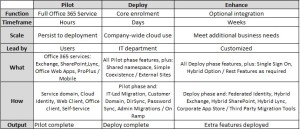I hope you’ve been through the beginning article to start with & move upwards in the ladder to “Design for Office 365 Infrastructure”
IT infrastructure projects, consultants, implementers, and IT professionals have to do a lot of planning and risk mitigation because they are building the new environment often from scratch, rather than migrating to an already proven system.
This is the key fact that enables you to implement the FastTrack approach for migrating to Office 365, thus reducing the time to get the customer to the live environment and mitigating the risks of the deployment.
Deployment Methodology : Old-Fashioned Approach
In a traditional on-premises deployment, you typically go through a structured process that involves many never-ending planning meetings, filling in numerous checklists, and attempting to reduce risks to the minimum acceptable level. The old Office 365 deployment model uses five phases, consisting of pre-deployment planning and consultation, followed by a planning phase, a preparation phase, the core migration phase, and some consequential post-deployment work to ensure everything is working correctly.
With an on-premises deployment, this complex, risk-adverse approach is understandable, particularly as you are migrating to an environment that is not working. But this approach does result in considerable disadvantages, which are at odds with the responsive nature of the Office 365 platform itself.
Deployment Methodology : Old-Fashioned Approach – Drawbacks
With the traditional deployment approach, you might spend several weeks or even months before you even get to the migrate phase—time when the customer is not able to experience the benefits of Office 365 first-hand. Even when you finally began your pilot deployment, that pilot environment would often be lightly used and then discarded, in effect invalidating the pilot and minimizing any useful operational experience that the pilot might provide.
The result of this approach is that it may be two or more months until the first users are migrated across to their Office 365 mailboxes, and three to four months before the organization finally benefits from moving to the new service. This situation is not ideal, both from the sales perspective and from the customer viewpoint.
A key message that you must fully appreciate is that cloud deployments are not like traditional on-premises deployments, and they need a new methodology to suit.
Deployment New-Fashioned Approach – Advantages
Instead of five phases, the FastTrack deployment process has only three main parts.
Pilot
The Pilot phase is implemented in hours and has minimal prerequisites. The aim is to get a representative group of users onto the service and redirecting their mail from their current messaging system to their Office 365 mailboxes. The overall aim is to:
- Use the service early.
- Allow the customer to use the service and see how it fits their needs.
- Show the options for a simple and quick deployment.
Deploy
The Deploy phase follows directly after the Pilot phase, so none of the pilot effort is wasted. The customer transitions rapidly into the live environment, which enables the organization to:
- Achieve broad production use quickly.
- Meet time to service use with deployment options.
Enhance
Finally, in the Enhance phase, the customer can include further optional enhancements to meet its business needs. If these additions are not required, they are simply never implemented.
This table breaks down the phases, identifying the function, time-frame, scale, and activities within each phase.
Stay tuned for the upcoming articles…




